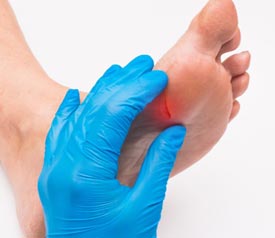
Foot wounds are very stressful to deal with for any amount of time. They make it difficult to walk and can make it impossible to put weight on the foot. Practicing proper podiatric wound care is essential to a speedy and full recovery.
With the correct foot wound care practices, a wound can heal fast and patients can get back to their regular lives. Most foot wounds will require the care of a doctor at first, but patients will also have to keep up with at-home care afterward. Keeping weight off the wound, dressing the wound properly, and taking the right medications can all be very helpful in the wound care process.
In this article, we’ll discuss the causes of foot wounds, the proper treatment of these wounds, and the best way to secure a foot dressing.
Causes of Foot Wounds
Many different problems can cause a foot wound. Two of the most common issues that result in a foot wound are accidents and illnesses.
Accidents happen all the time, resulting in wounds anywhere on the body. Walking on an extremely hot surface, stepping on a sharp object, or scraping your foot on a rough surface can all cause podiatric wounds. It’s important to clean out these wounds with soap and water immediately after they occur and potentially visit a doctor for further wound care.
Illnesses can also lead to foot wounds. Health conditions such as diabetes can have a negative effect on the feet. This can result in the development of wounds from the inside of the foot. A doctor should be consulted at the first signs of a podiatric wound that seems to appear on its own.
Proper Treatment of Podiatric Wounds
Working with a podiatrist is essential when dealing with foot wounds. They will be able to give specific directions to a patient based on the type and severity of the wound. With the help of a doctor, a foot wound can clear up much quicker than handling the situation completely alone.
A few common treatments for podiatric wounds include:
Off-loading the wound – When pressure is applied to a wound, it can cause more issues for the patient. Many wounds need to have reduced pressure or no pressure at all. This can make it tough for a patient to deal with regular activities like walking and standing.
A podiatrist may recommend special shoes, the use of a cane, or the use of a wheelchair while the foot wound heals. This will help lower or eliminate the pressure and friction being applied to the wound. Negative pressure treatment can also be an option for helping a wound heal over time.
Special foot wound dressing – Podiatric wounds need regular attention when it comes to wound dressings. The dressing must be secured properly and kept in place with adhesives such as Hy-Tape. Keeping the dressing in place with a waterproof tape that moves easily with the patient will help in the healing process.
Foot wound dressings should also be changed on a regular basis, either every few hours, every day, or every few days depending on the type of wound. A podiatrist can provide specific instructions on how often to change a dressing, as well as which ointments to use to help speed up the healing process.
Antibiotic medications – The biggest risk for podiatric wounds is bacteria. Even well-dressed wounds can be susceptible to bacterial infection and this can lead to longer healing times or improper healing. Antibiotic medications may be prescribed to help defend against bacteria.
A doctor can prescribe the specific medications or ointments that work best for the specific situation. Medications should always be taken on time and in the right way to help speed the healing process of a podiatric wound.
Securing a Podiatric Wound Properly
Keeping a wound dressing in place is vital for the healing process. Using a powerful tape like Hy-Tape is the best way to hold a wound dressing in place while also allowing for flexibility.
Wound dressings need to be kept waterproof so as to avoid infection. Hy-Tape offers a waterproof seal that keeps liquids out without sacrificing a tight hold.
Podiatric wounds may cause sensitivity in the nearby skin, so a wound dressing tape that peels off easily is also important. Hy-Tape can easily be removed and applied again between dressings.
Related Topics:
- Post Bunion Surgery Wound Care
- Podiatrists Trust Hy-Tape
- Negative Pressure Wound Therapy: A Focus on Diabetic Foot Wounds
Why Choose Hy-Tape for Securing a Podiatric Wound Dressing
Hy-Tape is known for its strength of hold, keeping a wound dressing right where it needs to be. The flexible material also moves easily with the patient so as to avoid pinching or chafing of the skin. It also peels off easily when replacement is needed, and it features zinc-oxide, an ingredient that protects the skin.
When you or your patients need a secure, waterproof, comfortable wound dressing tape for podiatric wounds, Hy-Tape is the best choice. Contact us today to learn more about our line of products.
Check out Podiatry & Wound Care Resources.

